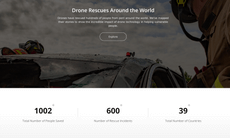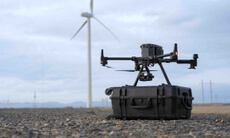June 21, 2016 – DJI, the world’s leading maker of unmanned aerial vehicles, welcomes a new Federal Aviation Administration (FAA) regulation announced Tuesday that will make it easier for American businesses, farmers, nonprofits and government agencies to use drones in their work.
DJI expects the “Small UAS Rule” will open up American skies to the safe and responsible use of unmanned aerial systems (UAS) for mapping, building and site inspections, agricultural surveys, commercial TV and film production, search-and-rescue operations, academic study, and countless other uses yet to be imagined. Links to videos of drones performing some of these tasks are available at the end of this release.
“This is a watershed moment in how advanced technology can improve lives, as the Small UAS Rule allows companies, farmers, researchers and rescue services alike to explore how drones can let them do more at a lower cost and a lower risk,” said Brendan Schulman, DJI Vice President of Policy and Legal Affairs, who for years has been deeply involved in the regulatory process to craft the new rule. “After years of work, DJI and other advocates for reasonable regulation are pleased that the FAA now has a basic set of rules for integrating commercial drone operations into the national airspace. There is more work ahead, and DJI thanks the FAA for encouraging the development of transformative aerial technology while ensuring the safety of those on the ground and in the air.”
The Small UAS Rule will become effective in 60 days, replacing the current FAA scheme that requires commercial drone operators to spend months waiting for an FAA exemption and to employ a pilot with a manned aircraft license from the FAA. Those high barriers to entry have prevented many companies from exploring the benefits of drones in their industry, and have been a source of frustration for business owners for years.
“The new rules codify common sense, making it easier for a farmer to fly a drone over his fields, for a contractor to inspect property without climbing a ladder, and for a rescue service to use drones to save lives,” said Jon Resnick, DJI Policy Lead. “The FAA recognized that the system needed to change, and worked closely with its industry partners to build a better system. We look forward to continued collaboration with them in the future.”
The Small UAS Rule includes important safety protections to ensure the widespread use of drones does not interfere with airplanes or threaten people on the ground. All non-recreational drone operators will need to pass an FAA test of aeronautical knowledge, be vetted by the Transportation Security Administration, and inspect their drones before every flight. They must stay clear of restricted areas and busy controlled airspace, and not fly directly over anyone on the ground unless that person is involved in the drone’s operation.
The Small UAS Rule does not change the safety requirements for operating drones for recreational purposes. Recreational users should continue to operate safely under the guidance developed by the FAA and explained in the “Know Before You Fly” campaign supported by industry leaders including DJI. DJI’s software includes many protections to help users fly safely and avoid inadvertently straying into areas that raise concerns. DJI was a member of the FAA UAS Registration Task Force in 2015 and the more recent Micro UAS Aviation Rulemaking Committee concerning UAS flight over people. Both of those efforts resulted in recommendations to the FAA concerning innovative regulatory approaches to civilian drone technology.
For additional information or to schedule interviews with DJI experts in New York and Washington, D.C., please contact:
Adam Lisberg, DJI Corporate Communications Director, North America – adam.lisberg@dji.com
Broadcast-quality videos of DJI drones in action are available on DJI’s YouTube channel:
Search and rescue in Maine: https://www.youtube.com/watch?v=IbkTzDchrzE
Firefighting in Connecticut: https://www.youtube.com/watch?v=qA3SEzNP4sY
Mapping earthquake damage in Nepal: https://www.youtube.com/watch?v=qA3SEzNP4sY
Studying whales in Mexico: https://www.youtube.com/watch?v=IPUYtYP8BwE
Thermal camera imaging: https://www.youtube.com/watch?v=Z625R9eljIc


